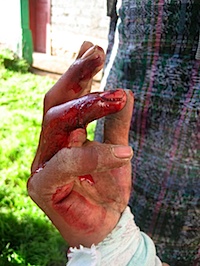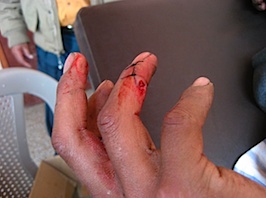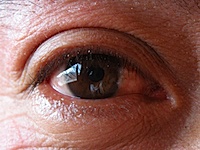Since we hang out with the health center staff and are “preventive health technicians” (says so on my bunsiness card, darn it!), we occasionally see some strange medical stuff. I came home the other day from a meeting, and there was a guy sitting in my front yard with an odd look of pain on his face, holding his hand up. This was to stop the bleeding, as he’d injured himself working with sheetmetal roofing. No one seemed to be doing anything, so I went in my house to get my trusty PeaceCorps(tm) Medical Kit. When I returned and got a better look, I realized that his finger was split in half lengthwise, and would not be within my capabilities to heal. About that time, my neighbor Reyna (who is a nurse) came out and asked me if I could call Lucia, another nurse buddy of ours, to ask if she knew where the suture kits were stored in the health post down the hill. A few minutes later, I found myself in the health post with Nas Palas and Reyna, stitching this guy up.
 “Being a nurse is hard work,” Nas Palas said. He was pouring hydrogen peroxide all over the guy’s hand as I held his arm steady and Reyna was setting up the suture kit. “All the kids nowadays go for easy jobs like teacher. They just work half days, and get a ton of days off all the time, and don’t have to do anything dirty.”
“Being a nurse is hard work,” Nas Palas said. He was pouring hydrogen peroxide all over the guy’s hand as I held his arm steady and Reyna was setting up the suture kit. “All the kids nowadays go for easy jobs like teacher. They just work half days, and get a ton of days off all the time, and don’t have to do anything dirty.”
 I could tell he was very proud of Reyna, his daughter, for taking the high road. She stuck the needle into the guy’s finger as Nas talked, and he winced a little. She wasn’t even on duty today, but that’s the luxury of having a nurse live in your village: they’re a one-man 24-hour emergency room. For small, rural villages like ours, that can be a lifesaver; Reyna is doing her entire community a great service just by existing.
I could tell he was very proud of Reyna, his daughter, for taking the high road. She stuck the needle into the guy’s finger as Nas talked, and he winced a little. She wasn’t even on duty today, but that’s the luxury of having a nurse live in your village: they’re a one-man 24-hour emergency room. For small, rural villages like ours, that can be a lifesaver; Reyna is doing her entire community a great service just by existing.
The first suture didn’t go so well; she passed the needle from the thicker part of the finger to the thinner, putting outward pressure on the cut instead of closing. She did the second one better. (You get what you pay for, even in the medical field?) Our patient is a farmer, so his finger was all muscle, and it took Reyna a LOT of pressure to pass the needle through it. If he wasn’t one of these tough-as-nails Mayan guys, I am sure he would have passed out.
A few minutes and a lot of groaning later, we were done. We cleaned him up, and sent him on his way.
One of the books on my shelf is Where There Is No Doctor , a clever book written by an aid worker doctor in the 70s in rural Mexico. It is a sortof do-it-yourself book of general medicine, designed to give rural health workers extra knowledge on how to diagnose and possibly fix things when there is no doctor available, as is the case in many parts of Central America and Africa. It also helps them identify cases that need emergency transport for professional help.
 The next day, I was talking to Manuel and noticed something funny in his eyes. Closer examination revealed fleshy protuberances from the inside corners of the whites of his eyes. I remembered seeing this condition in Where There Is No Doctor, and identified it as “pterygium“. It is not a critical condition, but if it gets bad enough, the fleshy bits can grow enough to cover the iris, causing blindness. The weird thing is, no one knows exactly what causes it or how to prevent it, but it occurs mostly in sunny, windy, gritty environments and at high altitudes, where the ultraviolet rays are the strongest. I thought of referring him to one of the medical jornadas like the one we helped with in February, but pterygium is apparently only operable when it gets worse than his, and even so, it often recurs after surgery. So I guess there is not much anyone can do.
The next day, I was talking to Manuel and noticed something funny in his eyes. Closer examination revealed fleshy protuberances from the inside corners of the whites of his eyes. I remembered seeing this condition in Where There Is No Doctor, and identified it as “pterygium“. It is not a critical condition, but if it gets bad enough, the fleshy bits can grow enough to cover the iris, causing blindness. The weird thing is, no one knows exactly what causes it or how to prevent it, but it occurs mostly in sunny, windy, gritty environments and at high altitudes, where the ultraviolet rays are the strongest. I thought of referring him to one of the medical jornadas like the one we helped with in February, but pterygium is apparently only operable when it gets worse than his, and even so, it often recurs after surgery. So I guess there is not much anyone can do.
In the health center staff meeting on Thursday, we heard a pretty disturbing story. As we’ve mentioned before, our municipality has a host of reproductive-health problems: the worst maternal mortaliy rate in Guatemala (we have 10 dead mothers already this year), a dozen children per family, teenage pregnancy, the works. Our buddy Aurelio told a story about how he was on duty a few weeks ago and got a call from a midwife around midnight. Apparently, her 12-year-old patient had been in labor for 15 hours and the baby was not coming. She called in a second midwife, who advised her to transport the patient to the hospital. Could Aurelio come with our new ambulance, to pick them up?
When he arrived, the 12-year-old girl was lying by the side of the road in a torrential dowpour. The father came out of the house, and a a dispute started. He was adamant that the girl not be taken to the hospital, because it was unnecessary and he couldn’t afford it anyways. “If she dies,” he said to Aurelio, “it’s the will of God.”
Aurelio, of course, would have none of it. They argued for a while and then Aurelio called the police. “If she dies,” Aurelio said, “the police will take you to jail for murdering your daughter, since she’s still a minor and under your protection.” The man got even angrier, threw his hands up, and walked off. Aurelio and the driver put her in the ambulance and headed for Soloma, an hour away, since it’s the closest 24-hour health facility.
When they arrived, the doctor looked at the girl and immediately identified the problem. Her pelvic opening was smaller than the baby; it would be physically impossible for her to give birth. The health center in Soloma is equipped for deliveries but not for Cesarians, so they transferred her to a private clinic nearby.
The story ends happily, this time. The girl and baby survived. But, in a typical Guatemalan twist, the girl is now a captive in the private clinic, since their services aren’t free and they want to get paid. The father doesn’t have a cent to his name, so the town is now taking up a collection to pay her 8,000q surgery bill (that’s about $1000 US) so she can go home. How’s that for crazy?